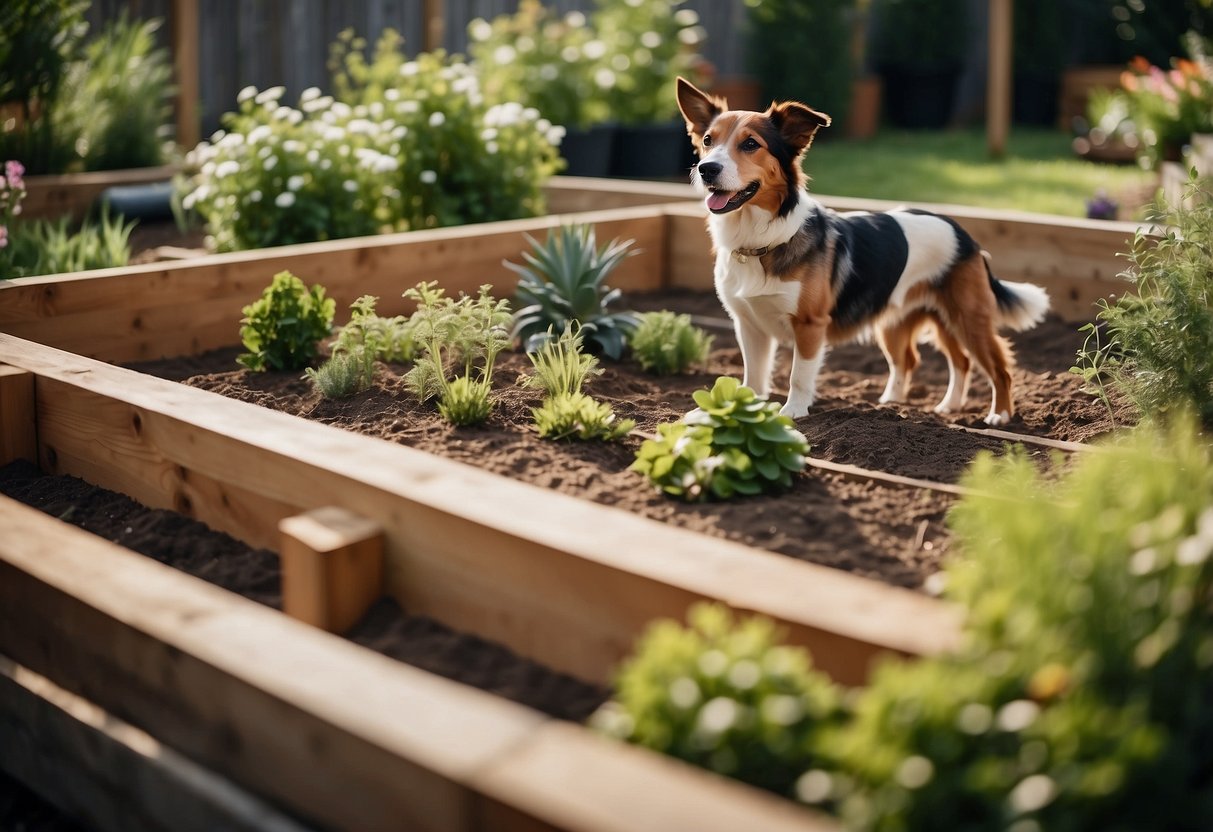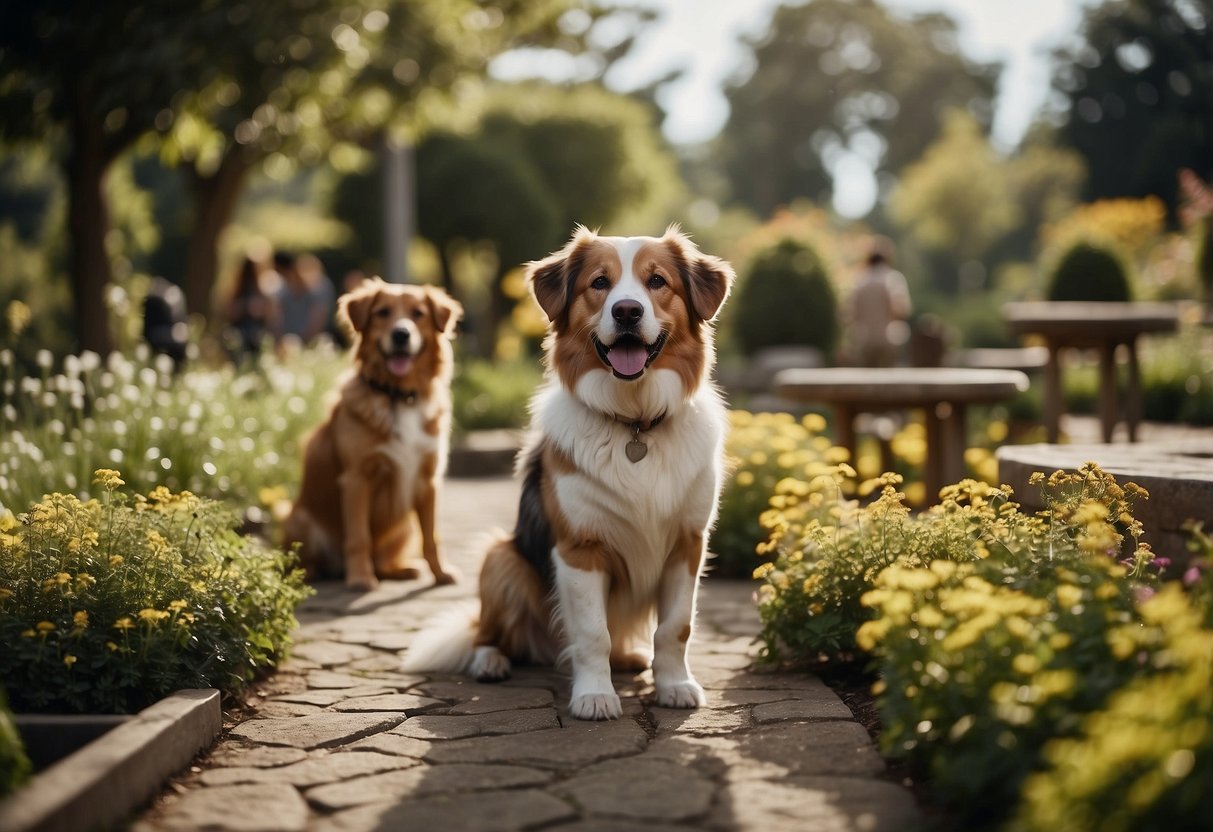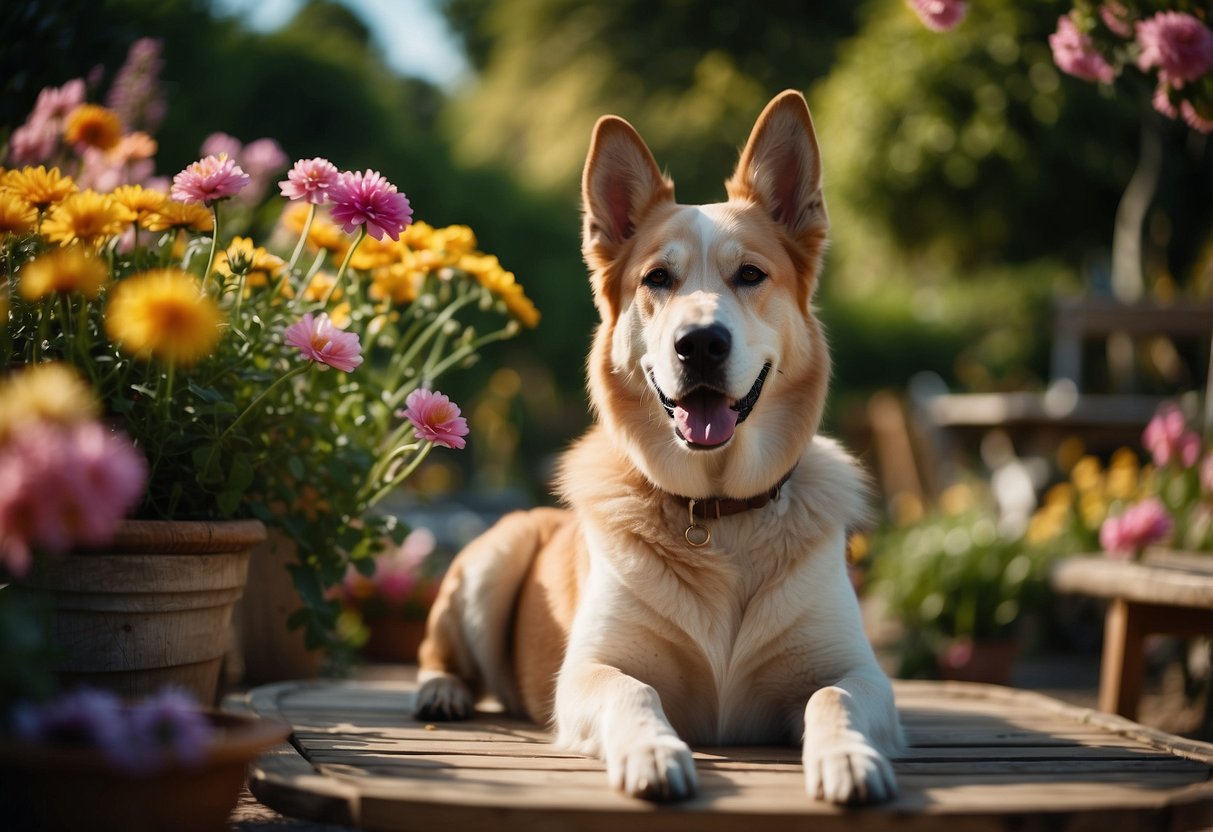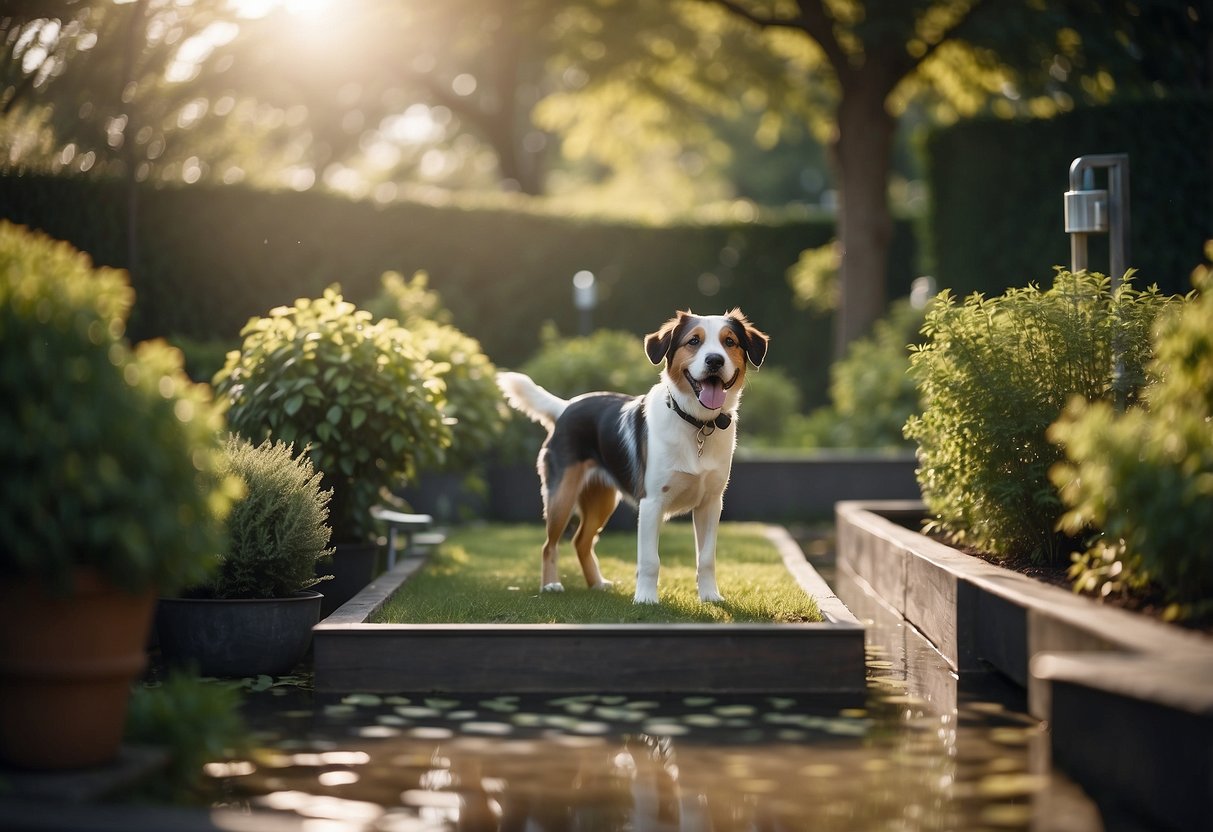Garden Ideas When You Have Dogs: Tips for a Pet-Friendly Yard
Creating a pet-friendly garden can be both fun and rewarding. You want a space where your dog can play without causing damage to your plants. It’s important to consider your dog’s needs while keeping your garden looking great.

Can you make your garden a safe and happy place for your dog? Yes, you can! By implementing some clever landscaping ideas, you can enjoy a beautiful garden that’s also a haven for your furry friend.
1) Designated Doggy Paths

Creating designated doggy paths in your garden can help keep both the plants and your pup happy. By providing clear paths, you give your dog a space to roam without trampling your flowers.
Use materials like stone, gravel, or mulch for these paths. These are gentle on paws and look great.
Consider adding borders using driftwood or low fencing. This can help guide your dog to stay on the paths and away from delicate plants.
2) Secure Fencing Solutions

When you have a dog, secure fencing is essential to keep them safe. One of the top choices is an aluminum fence. Aluminum fences are sturdy and hard for dogs to climb or jump over.
Another option is the invisible dog fence system, which uses a tone-only mode to keep your dog within bounds without a physical barrier.
Consider a concrete footer if your dog loves to dig. Pouring concrete along the fence line can prevent escape attempts.
For jumpers, try installing coyote rollers.
3) Raised Plant Beds

Raised plant beds are a great way to keep your garden safe from dogs. By elevating your plants, your dogs can’t easily access them. This helps protect your flowers and vegetables from playful paws.
You can build raised beds from wood, metal, or even recycled materials. The height can vary, but a foot off the ground usually works well. This height discourages dogs from jumping in and digging.
Raised beds also make gardening easier on your back. You can tend to your plants without bending down too much. Plus, they add a neat, organized look to your garden space.
4) Dog-friendly ground covers

If you’re looking for a ground cover that’s safe and fun for your dog, consider Zoysia Grass. It’s great for warm, dry climates and is very sturdy.
Another good option is Irish Moss. It’s easy to maintain and grows tiny, white flowers in the spring.
For a colorful choice, try Labrador Violet. It’s non-toxic and adds a splash of purple to your yard.
5) Chew-proof garden furnishings

Choose furniture made from metal or treated wood, which are sturdy against dog chewing.
Look for outdoor furniture with removable and washable covers. These are easy to clean and can prevent damage from teeth and claws.
Consider installing furniture covers to protect your chairs and couches from bites and scratches.
6) Non-toxic plants

When planning your garden, choose plants that won’t harm your dogs.
Sunflowers are a great choice. They are bright, beautiful, and safe for furry friends.
Snapdragons add color and are also non-toxic. They thrive in sunny spots.
Consider planting some basil, which is not only dog-safe but also useful in the kitchen.
For more options, check out this list of dog-friendly plants.
7) Shade and Hydration Stations

Your dog needs a cool place to rest on hot days. Set up shaded areas in your backyard. Trees, umbrellas, and shade sails work great for this.
Provide fresh water at all times. Consider pet-safe water features like shallow fountains or bowls. These can make it fun for your dog to stay hydrated. Keep refilling with clean water.
設さぁh
8) Digging Zones with Sand

Creating a dedicated digging zone with sand can keep your garden safe while letting your dog have fun. Use soft play sand, as it’s gentle on their paws and safe if ingested.
Excavate about a foot of topsoil, line the area with landscape fabric, and fill it with the play sand. This setup keeps other animals out and helps you clean it easily.
Cover the sand pit at night to prevent any unwanted messes, and rake a mix of water and distilled white vinegar through the sand every few months to keep it fresh.
9) Pet-safe pest control

Keeping your garden free from pests while ensuring your dog’s safety is important. One effective method is using a DIY neem oil spray. Mix one quart of water, one teaspoon of neem oil, and a quarter teaspoon of castile soap.
You can also plant insect-repellent herbs like rosemary and sage to naturally deter pests. These are safe for dogs and help keep mosquitoes and fleas away.
Consider using products with natural ingredients like Sodium Lauryl Sulfate, which is found in some pet-safe sprays. This ingredient is less toxic and effective against insects.
10) Doggy splash zone

Your backyard can be a fun and refreshing place for your dog with a doggy splash pool. A shallow pool or water feature will let your pup cool off on hot days.
Make sure the splash zone is safe and easy to clean. A non-slip surface around the pool can help prevent accidents. Keep the area shaded to protect your dog from too much sun.
Creating A Dog-Friendly Garden

When creating a dog-friendly garden, it’s important to choose safe plants and design play areas that cater to your dog’s needs. This ensures a safe and enjoyable space for both your pet and your garden.
Choosing Dog-Safe Plants
Selecting dog-safe plants is crucial to keeping your pet healthy. Some plants can be toxic to dogs, causing various health issues if ingested. It’s best to avoid plants like lilies, daffodils, and oleander. Instead, opt for non-toxic varieties such as marigolds, sunflowers, and roses.
Additionally, consider plants that are durable and can withstand your dog’s playful nature. Hardy plants like lavender and rosemary are good choices, since they are less likely to be damaged. Using raised beds or sturdy borders can also protect more delicate plants from being trampled.
Keeping a list of common toxic plants away from your garden is a helpful precaution. Regularly monitor your garden to ensure no harmful plants sneak in and always consult a vet if you’re unsure about a specific plant.
Designing Play Areas
Designing play areas for your dog is vital for their exercise and mental stimulation. Designate specific zones in your garden where your dog can run, dig, and play. This helps keep the garden organized and reduces the chances of plants being damaged.
Consider creating paths with materials like gravel or mulch. These are gentle on paws and easy to clean. Adding a dog-friendly water feature, like a shallow pool or a splash pad, can provide a fun way for your dog to cool down on hot days.
You can also introduce interactive elements such as agility equipment or digging zones. Encourage your dog to use these areas with treats or toys, guiding them to explore and enjoy their designated play spaces. Regularly update these play areas to keep your dog engaged and happy.
Protecting Your Plants From Dogs

To keep your garden flourishing while ensuring your dog can safely enjoy the outdoor space, consider using barriers and fencing, and training your dogs. These methods can help prevent damage to your plants and provide a peaceful garden environment.
Using Barriers And Fencing
Installing fences around your garden is a simple and effective way to protect your plants from your dog.
Dog-proof fencing can be made from various materials like wood, vinyl, or metal. It’s essential to choose a fence that is tall enough to prevent your dog from jumping over. For small dogs, a 24-inch barrier often works, but larger or more active dogs may need a fence around 36 inches high.
Underground barriers can also be crucial. Extend the fence below-ground to stop your dog from digging under the fence. Mesh or chicken wire is suitable for this purpose.
You might also try using raised garden beds. These not only protect plants from trampling but also make it harder for your dog to eat or dig up your flowers and vegetables.
Training Your Dogs
Training is key to keeping your plants safe. By teaching your dog certain boundaries within the yard, you can ensure they enjoy the space without causing damage.
Start by rewarding positive behavior. When your dog avoids the garden area, offer treats or praise. Consistency is crucial. Make sure everyone in your household reinforces these boundaries.
Consider using commands like “leave it” or “stay” to guide your dog’s actions around the garden. Regular practice of these commands can instill long-term good behavior.
You might also create a designated play area for your dog. Fill it with toys or an area with soft ground. This can help redirect your dog’s energy away from your garden and into a space where they can dig and play without causing harm.
Maintaining A Clean And Safe Garden

To keep your garden clean and safe for your dog, start by choosing the right surfaces. Artificial grass is popular because it’s low maintenance and gentle on paws. You can check more about it on dog-friendly garden design ideas.
Paving pathways with materials like brick or gravel helps keep paws dry and clean. Trained dogs will usually stick to these paths, protecting your garden beds. According to Better Homes & Gardens, mulched paths can also work well, but avoid cocoa bean hulls since they can be toxic to dogs.
Creating shaded areas and providing plenty of water is essential. Consider a pet-safe water feature for hydration and fun. Homes & Gardens suggests shallow water features as the safest options.
Plant selection is crucial. Avoid plants toxic to dogs, such as azaleas and lilies, and choose safer options like marigolds and snapdragons. You can learn more about safe plants for dogs from this Rover guide.
Regularly clean up after your dog to maintain a healthy environment. Pick up waste promptly and keep the garden free of debris. Having designated potty areas can help manage this.
Lastly, consider bordering your garden beds with low fences or raised edges. This can help keep your garden tidy and prevent curious paws from digging up plants.







